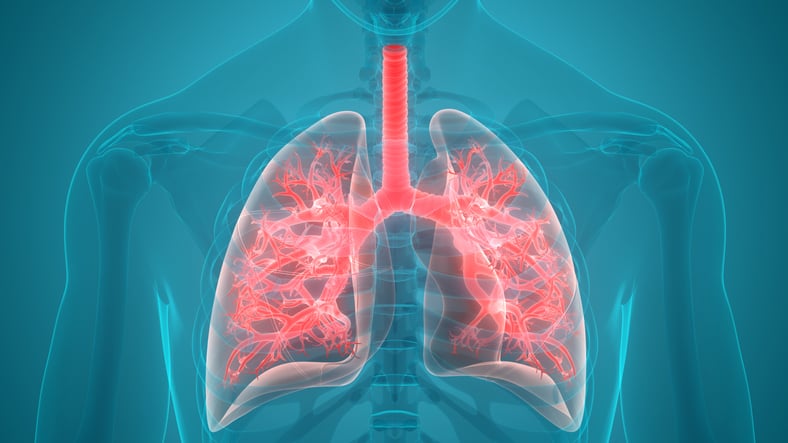
Even a small decline in lung function, as measured by reductions in forced expiratory volume in the first second (FEV1), appears to be a stronger predictor of sudden cardiac death than non-fatal coronary events.
Among otherwise healthy middle-aged adults, measurably lower lung function was associated with a greater risk for both sudden cardiac death (SCD) and non-fatal myocardial infarction in an observational study, but the association with sudden cardiac death was significantly stronger.
The link between reduced FEV1 and sudden cardiac death was observed for even modestly low lung function still within the normal range.
The study findings were presented this week at the European Respiratory Society virtual meeting, ERS International Congress 2021, by researcher Suneela Zaigham who is a post doctoral fellow at Lung University, Sweden.
Zaigham noted that the preliminary research suggests a possible role for FEV1 measurement in identifying otherwise healthy, middle-aged adults with an elevated risk for sudden cardiac events.
“We believe this is the first study to directly compare the risk of sudden cardiac death and non-fatal cardiac events and their links with lung function in the general population,” she noted in a written press statement.
“Our findings suggest that testing people’s lungs when they are middle-aged and healthy could help spot those who have a higher risk for sudden cardiac death. This could enable people to take steps to potentially reduce the risk of this devastating development.”
Commenting on the preliminary findings, incoming ERS president Marc Humbert, who is a professor of respiratory medicine at France’s Universite Paris-Saclay, noted that additional research is warranted to explore the potential link between lung function and sudden cardiac death and to determine if FEV1 measurement could be useful for risk screening.
“(This study) shows a higher risk of fatal than non-fatal coronary events even in people whose lung function is moderately lower but may still be within normal range,” Humbert stated. “This is something we can measure fairly easily, meaning that lung function could be used as part of a screening tool.”
In her recorded presentation, Zaigham noted that while poor lung function is a strong predictor of future cardiac events, it has not been clear if the pattern of lung function impairment differs for the prediction of sudden cardiac death and non-fatal coronary events.
In an effort to explore this question, the researchers analyzed baseline spirometry assessments in 28,584 middle-aged people with no history of coronary events upon enrollment in the preventive screening and follow-up program Malmo Preventive Project.
The Malmo Preventive Project was initiated in the early 1970s as a screening survey for middle-aged residents of Malmo, Sweden. The screening focused on cardiovascular risk factors and alcohol abuse, and participants were followed in subsequent years and offered interventions if they were determined to be at risk.
“We aimed to assess if measures of spirometry were more strongly associated with future sudden cardiac death, which was defined as death on the day of an incident coronary event occurring in or outside of hospital, than non-fatal coronary event, which was defined as an incident coronary event survived for the first 24 hours,” Zaigham said in her presentation.
The cohort included in the analysis was followed prospectively for sudden cardiac death and non-fatal cardiac event and Cox regression modeling was used in conjunction with a modified version of Lunn McNeil’s competing risk method to assess lung function and risk for sudden cardiac death and non-fatal coronary events.
Among the main findings:
- A 1-standard deviation (SD) reduction in FEV1 was associated with a 23% increased risk for sudden cardiac death (HR, 1.23; 95% CI, 1.15-1.31) and an 8% increased risk for non-fatal coronary event (HR, 1.08; 95% CI, 1.04-1.13).
- The p value for equal association equalled 0.002 and similar associations were found for a 1-SD reduction in forced vital capacity (FVC), but not FEV1/FVC.
- The results remained significant even in life-long never smokers (1-SD reduction in FEV1 HR for SCD: 1.34, 95% CI, 1.15-1.55 and for non-fatal coronary event: 1.11, 95% CI 1.02-1.21: P value for equal association = 0.038).
A significant study limitation cited by the researchers was their inability to measure risk factor changes in the years after participants completed questionnaires and testing was conducted.
Zaigham noted that future research goals include investigating whether sudden cardiac death might be prevented by testing lung function routinely in cardiovascular risk assessment and further exploring the mechanism linking poorer lung function to sudden cardiac death.
-
Among otherwise healthy middle-aged adults, measurably lower lung function was associated with a greater risk for both sudden cardiac death (SCD) and non-fatal myocardial infarction in an observational study, but the association with SCD was significantly stronger.
-
The link between reduced FEV1 and sudden cardiac death was observed for even modestly depressed lung function still within the normal range.
Salynn Boyles, Contributing Writer, BreakingMED™
The researchers declared no relevant conflicts related to this study.
Cat ID: 195
Topic ID: 89,195,730,102,914,192,195,63,925,203


